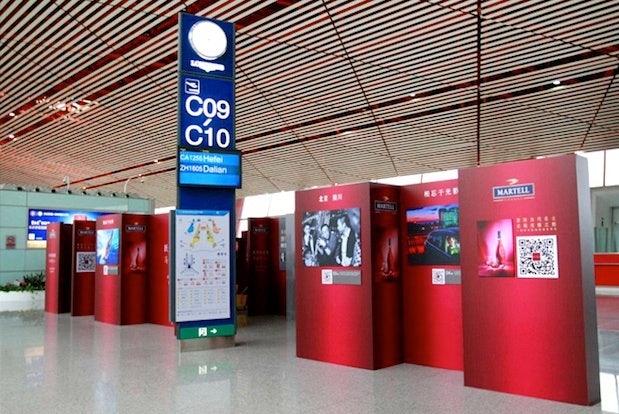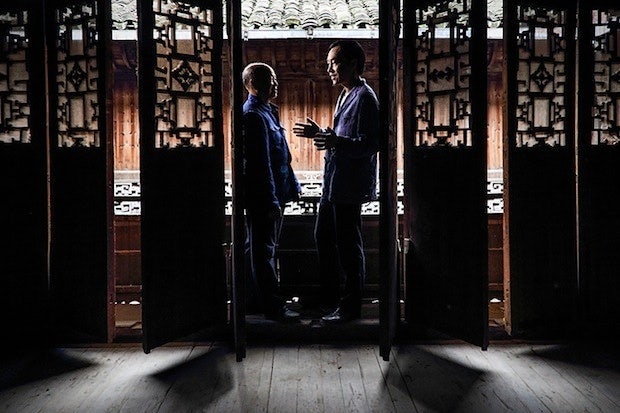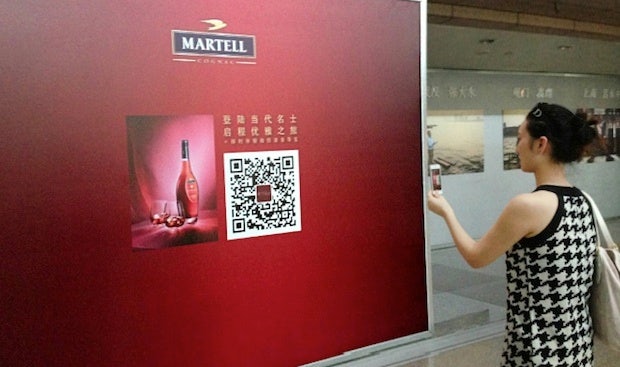
Martell's airport exhibition that accompanied its recent "modern celebrities" ad campaign, featuring QR codes that passers-by were able to scan. (Damn Digital)
Travelers making their way through Beijing’s Capital and Shanghai’s Pudong airports this fall had the opportunity to participate in an innovative new ad campaign by Martell Noblige Cognac that combined mobile and offline marketing with a focus on interactive participation by consumers.
The campaign, entitled Dangdai Mingshi, Yingxiang Xun Lu (当代名士•映像寻旅) in Chinese, which translates roughly into something like “Modern Elites and their Journey of New Elegance”, sent famous photographer Justin Jin to six Chinese cities—Beijing, Shanghai, Xiamen, Wuhan, Shenzhen and Guangzhou—to photograph “men of elegance” in each city. Created by ad firm TBWA’s Shanghai office, the campaign’s “Elegance” theme was chosen to fit in with the “New Elegance” slogan of Martell Noblige Cognac. With profiles of successful figures in the arts such as Beijing film director Lu Chuan and Shenzhen television host Dou Wentao, the campaign follows in the footsteps of other recent “role model” marketing campaigns in China by Mercedes-Benz and Johnnie Walker, but incorporates an offline interactive feature in order to organically generate a substantial number of new WeChat fans.

One of the photographs used in the campaign. (Martell/Justin Jin)
The Beijing and Shanghai airports both featured interactive exhibition of Jin’s photography with a special QR code below each photo. Scanning the QR code allowed users to access the brand’s WeChat page and access profiles of each “elegant man” with audio descriptions of their accomplishments. The campaign also featured a free plane ticket giveaway to winning participants, and those who were not physically in the airport had the opportunity to send a number or voice command via WeChat in order to be entered in the drawing.

The airport campaign in action. (Damn Digital)
The marketing benefits of this campaign were numerous. By using WeChat as a platform for the increasingly popular online-to-offline (O2O) marketing model, the campaign encouraged active engagement with the ads rather than passive viewing, and was aimed at encouraging users to follow Martell on the most widely used mobile-social app in China. In addition, the choice of airports to house the offline portion of the campaign not only targets an area of high foot traffic, but is able to attract China’s traveling shoppers who may be making a stop at a duty-free shop at some point along their journey. Meanwhile, the focus on local celebrities in several key cities allowed the company to tap valuable and rapidly growing second-tier markets in a way that would resonate locally.
With thousands of participants and hundreds of new WeChat fans for the brand, the campaign was pronounced a success in O2O marketing innovation. Although not numbering in the tens of thousands that can be gained from successful Sina Weibo campaigns, WeChat followers are valuable for several reasons: first of all, WeChat content has higher impact in reaching users because it doesn't become immediately replaced with new content as it does on Sina Weibo. Secondly, the nature of the campaign attracted participants who would be actively engaged in with the brand, and thus more likely to engage in the future.